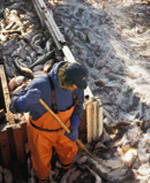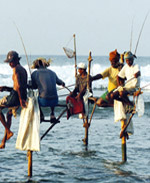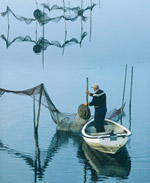- Getting stock management right
- > Overexploited stocks, unemployed fishermen, short-sighted structural policy – it is impossible to ignore that fisheries management has failed in many respects. Nonetheless, we can all learn from the positive approaches being taken in some regions. These aim to conserve fish species and ecosystems and take account of the social dimension – objectives which the European Union has yet to achieve with its current reform of fisheries policy.

Learning from bitter experience?
Today, many fish stocks are in a poor state because they were badly managed, or not managed at all, for many years. One reason for their parlous condition is that policy-makers and fishing companies have often disregarded scientists’ recommendations on Total Allowable Catch. From the scientists’ perspective, the TACs were meant to be upper limits which should not be exceeded; their aim was to ensure that stocks were not put at risk. However, policy-makers and the fishing industry viewed these upper limits as recommendations on the maximum amount that could be caught. With disastrous results: in years when stocks were already in an unhealthy state due to poor environmental conditions, fishing activities often exceeded the level that stocks could reasonably sustain. Quick profits or short-term protection of jobs were often viewed as more important than the recovery of stocks and the creation of a sustainable, high-yielding fishing industry for the long term. There now appears to be a willingness to learn from past mistakes, with alternative and more sustainable fisheries management strategies slowly coming to the fore all over the world. These strategies are based on the concept of maximum sustainable yield (MSY), i.e. the amount that can be harvested with a view to maintaining abundant stocks for the long term. This concept can be easily adapted to diverse local conditions and allows countries to tailor their approach, also taking account of the social dimension. In future, fisheries management strategies based on the MSY principle should also consider the interaction between the various species and the impact of fishing on the ecosystem. These modern fisheries management strategies also aim to promote more stakeholder involvement in order to identify solutions which are acceptable to everyone. The stakeholders concerned are fishermen, relevant authorities, professional associations and environmental organizations at regional and local level. But how can all these various aspects be reconciled within the framework of the Common Fisheries Policy (CFP)? That is currently the subject of intense debate in Europe. The problem with the previous fisheries policy was that outdated provisions constantly had to be revised and improved upon. This led to a plethora of rules which were often ignored, and made compliance extremely difficult to monitor. One problem which is still largely unresolved is the issue of discards: unwanted bycatch is simply dumped overboard. This causes the wastage of millions of tonnes of fish and marine fauna all over the world every year. Fish which cannot be landed because they do not make the grade in terms of size, or because no quota is in place for the species, are very likely to be discarded. The practice of high-grading is also a problem: this means that fishermen pick out the most valuable parts of the catch and dump the rest overboard. Various methods are currently being discussed to reduce the quantity of discards, such as more intensive deployment of government observers or onboard surveillance using CCTV. This type of system is now being trialled on some fishing vessels in the North Sea and the Baltic Sea. The European Commission is also keen to use the CFP as an opportunity to demand more industry responsibility, which turns the spotlight on fishermen themselves. Anyone whose fishing practices result in several species being netted simultaneously will be required to obtain a licence for each of the relevant species. This is intended to encourage fishermen to set their nets in areas where only one species of fish is likely to be caught, or to use nets which are designed to catch one specific species.


